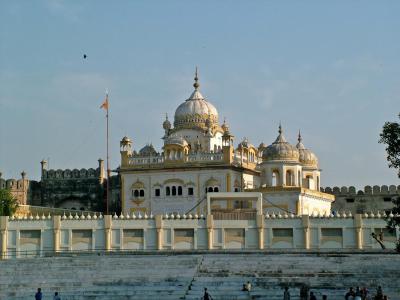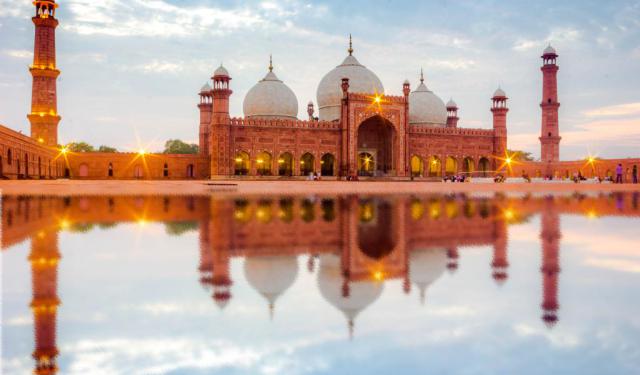
Samadhi of Ranjit Singh, Lahore
The Samadhi of Ranjit Singh, a 19th-century architectural masterpiece, stands as a tribute to the legacy of Sikh Maharaja Ranjit Singh (1780 – 1839). This historic monument holds the funerary urns of the revered Maharaja. Additionally, it shares its surroundings with the Gurdwara Dera Sahib, a place marking the spot where Guru Arjan Dev, the fifth guru of Sikhism, breathed his last.
The construction of this awe-inspiring structure commenced under the reign of Maharaja Kharak Singh, the son and successor of Ranjit Singh, following the Maharaja's passing in 1839. Nine years later, in 1848, the construction was completed under the supervision of his youngest son, Duleep Singh. The Samadhi overlooks the Hazuri Bagh, another splendid creation attributed to Ranjit Singh himself.
What makes the Samadhi of Ranjit Singh truly remarkable is its fusion of architectural styles, seamlessly blending elements from Sikh, Hindu, and Islamic traditions. The building boasts gilded fluted domes and cupolas, exuding an air of regal grandeur. Along the upper portion of the structure, an intricate and ornate balustrade adds to its visual appeal.
As you approach the entrance, the front doorway greets you with images of Ganesh, Devi, and Brahma, painstakingly carved from red sandstone. The central dome is adorned with unique Nāga (serpent) hood designs, a testament to the Hindu craftsmen who contributed their artistry to this project. Inside, the wooden panels of the ceiling are adorned with delicate stained glass work, while the walls are resplendent with intricate floral designs. The ceilings themselves are adorned with the exquisite artistry of glass mosaics.
At the heart of this sacred monument lies the resting place of Maharaja Ranjit Singh. His ashes are enshrined within a marble urn fashioned in the shape of a lotus. This urn is lovingly sheltered beneath a marble pavilion, a true masterpiece of pietra dura inlay work. Surrounding the Maharaja are smaller urns that contain the ashes of four Hindu sati queens and seven concubines, a testament to the rich cultural tapestry and harmonious coexistence of various traditions during that era.
The construction of this awe-inspiring structure commenced under the reign of Maharaja Kharak Singh, the son and successor of Ranjit Singh, following the Maharaja's passing in 1839. Nine years later, in 1848, the construction was completed under the supervision of his youngest son, Duleep Singh. The Samadhi overlooks the Hazuri Bagh, another splendid creation attributed to Ranjit Singh himself.
What makes the Samadhi of Ranjit Singh truly remarkable is its fusion of architectural styles, seamlessly blending elements from Sikh, Hindu, and Islamic traditions. The building boasts gilded fluted domes and cupolas, exuding an air of regal grandeur. Along the upper portion of the structure, an intricate and ornate balustrade adds to its visual appeal.
As you approach the entrance, the front doorway greets you with images of Ganesh, Devi, and Brahma, painstakingly carved from red sandstone. The central dome is adorned with unique Nāga (serpent) hood designs, a testament to the Hindu craftsmen who contributed their artistry to this project. Inside, the wooden panels of the ceiling are adorned with delicate stained glass work, while the walls are resplendent with intricate floral designs. The ceilings themselves are adorned with the exquisite artistry of glass mosaics.
At the heart of this sacred monument lies the resting place of Maharaja Ranjit Singh. His ashes are enshrined within a marble urn fashioned in the shape of a lotus. This urn is lovingly sheltered beneath a marble pavilion, a true masterpiece of pietra dura inlay work. Surrounding the Maharaja are smaller urns that contain the ashes of four Hindu sati queens and seven concubines, a testament to the rich cultural tapestry and harmonious coexistence of various traditions during that era.
Want to visit this sight? Check out these Self-Guided Walking Tours in Lahore. Alternatively, you can download the mobile app "GPSmyCity: Walks in 1K+ Cities" from Apple App Store or Google Play Store. The app turns your mobile device to a personal tour guide and it works offline, so no data plan is needed when traveling abroad.
Samadhi of Ranjit Singh on Map
Sight Name: Samadhi of Ranjit Singh
Sight Location: Lahore, Pakistan (See walking tours in Lahore)
Sight Type: Attraction/Landmark
Guide(s) Containing This Sight:
Sight Location: Lahore, Pakistan (See walking tours in Lahore)
Sight Type: Attraction/Landmark
Guide(s) Containing This Sight:
Walking Tours in Lahore, Pakistan
Create Your Own Walk in Lahore
Creating your own self-guided walk in Lahore is easy and fun. Choose the city attractions that you want to see and a walk route map will be created just for you. You can even set your hotel as the start point of the walk.
Lahore Introduction Walking Tour
"Lahore Lahore Hai." This popular Punjabi song (translating as "Lahore is Lahore") emphasizes the uniqueness and special character of this city, suggesting that there is no place quite like it. Also known as the "Pearl of the Punjab," Lahore is the second-largest city in Pakistan.
The name "Lahore" itself has a rather intriguing story. Some historians... view more
Tour Duration: 2 Hour(s)
Travel Distance: 2.8 Km or 1.7 Miles
The name "Lahore" itself has a rather intriguing story. Some historians... view more
Tour Duration: 2 Hour(s)
Travel Distance: 2.8 Km or 1.7 Miles

